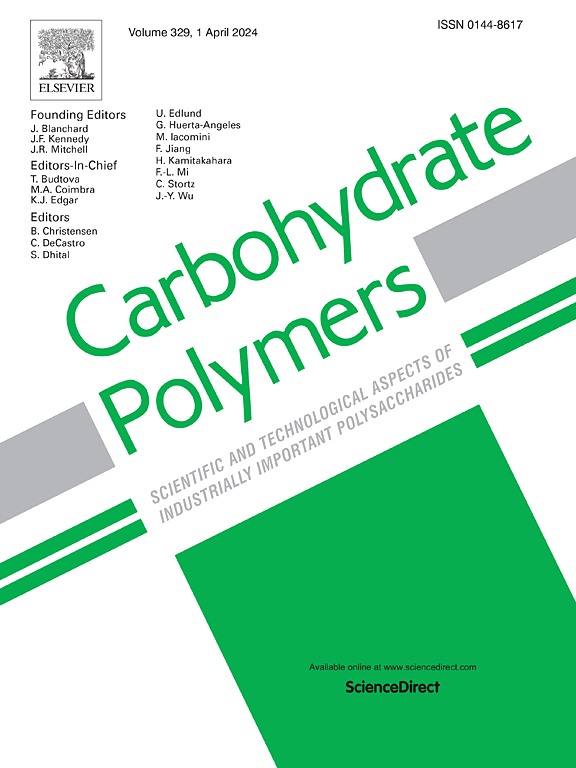果胶修饰纳米硒对辣椒疫霉的抑制机理及对辣椒抗病性的提高
IF 10.7
1区 化学
Q1 CHEMISTRY, APPLIED
引用次数: 0
摘要
影响辣椒生产的主要病害是疫霉病,纳米硒(nano- se)防治效果较好,但贮藏要求高,耐热性低。不同的果胶量可以得到0.1%、0.5%、1%和2%浓度的果胶修饰纳米硒(nano-Se@PT)。随着果胶含量的增加,nano-Se@PT粒径减小,zeta电位值升高,热重温度升高。nano-Se@PT的掺入可以提高其在40℃和70℃下的稳定性和耐热性。Nano-Se@PT在杀真菌和抑制辣椒疫霉方面优于纳米硒。体外抑菌实验表明nano-Se@PT能显著抑制菌丝生长,EC50约为4 mg/L。吸附在菌丝表面的微粒,通过破坏细胞膜、线粒体和细胞核而导致死亡。非靶向代谢组学分析表明,nano-Se@PT治疗破坏了菌丝的生长和代谢,改变了氨基酸、核苷酸和糖的水平。体内实验中,2% nano-Se@PT的疾病指数最低,预防效果最好。根际土壤微生物分析表明,nano-Se@PT在辣椒植株中招募了拟杆菌、乳杆菌和双歧杆菌等有益微生物,提高了辣椒植株对辣椒疫霉的抗性和生长。研究结果表明nano-Se@PT可能是一种独特的辣椒病害控制技术,为植物真菌病害管理提供了新的思路。本文章由计算机程序翻译,如有差异,请以英文原文为准。

Inhibition mechanism of pectin-modified nano-selenium on Phytophthora capsici and the improvement of the resistance in pepper
The principal disease impacting pepper production is Phytophthora blight, which nano‑selenium (nano-Se) controls well but has high storage requirements and low heat resistance. Varying pectin amounts yielded pectin-modified nano-Se (nano-Se@PT) with 0.1 %, 0.5 %, 1 %, and 2 % concentration. As pectin content grew, nano-Se@PT particle size reduced, zeta potential value rose, and thermogravimetric temperature climbed. The incorporation of nano-Se@PT can improve its stability and thermal resistance at 40 °C and 70 °C. Nano-Se@PT outperformed nano-Se in fungicidal and Phytophthora capsici inhibition. In vitro antifungal experiments showed that nano-Se@PT could significantly inhibit mycelium growth with an EC50 of about 4 mg/L. The particles adsorbed on the surface of mycelium, inducing death by destroying cell membranes, mitochondria, and nuclei. Non-targeted metabolomics analysis showed that nano-Se@PT treatment disrupted the mycelium growth and metabolism and changed amino acids, nucleotides, and sugar levels. In vivo experiments, 2 % nano-Se@PT had the lowest disease index and the best preventive therapy. Rhizosphere soil microbial analysis showed that nano-Se@PT recruited beneficial microorganisms such as Bacteroides, Lactobacillus, and Bifidobacterium in pepper plants, improving their Phytophthora capsici resistance and growth. The findings suggest that nano-Se@PT might be a unique pepper disease control technique and shed light on plant fungal disease management.
求助全文
通过发布文献求助,成功后即可免费获取论文全文。
去求助
来源期刊

Carbohydrate Polymers
化学-高分子科学
CiteScore
22.40
自引率
8.00%
发文量
1286
审稿时长
47 days
期刊介绍:
Carbohydrate Polymers stands as a prominent journal in the glycoscience field, dedicated to exploring and harnessing the potential of polysaccharides with applications spanning bioenergy, bioplastics, biomaterials, biorefining, chemistry, drug delivery, food, health, nanotechnology, packaging, paper, pharmaceuticals, medicine, oil recovery, textiles, tissue engineering, wood, and various aspects of glycoscience.
The journal emphasizes the central role of well-characterized carbohydrate polymers, highlighting their significance as the primary focus rather than a peripheral topic. Each paper must prominently feature at least one named carbohydrate polymer, evident in both citation and title, with a commitment to innovative research that advances scientific knowledge.
 求助内容:
求助内容: 应助结果提醒方式:
应助结果提醒方式:


